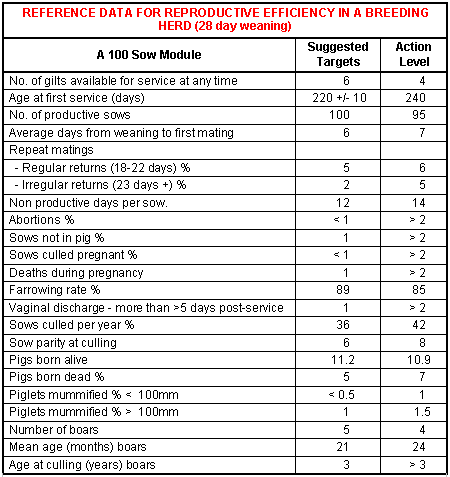



The use and interpretation of records
The causes of infertility cannot be determined and corrective action taken without collecting reliable information and using it in a meaningful way. Records required for each breeding female to understand reproductive failure:
- The sow number.
- The number of litters or parity.
- The dates of mating, farrowing and weaning.
- The number of services at each mating.
- The service quality. (Rate each service as 1, 2 or 3 - good, moderate or poor).
- The boar used or AI.
- The lactation length.
- Mummified piglets and their size.
- The numbers born alive/dead.
- The weaning to service interval.
Records required for the breeding herd
- Litter size variation * (scatter).
- Repeat matings - and their intervals in days.
- Abortions - and the age of foetuses
- Females found not in pig.
- Discharges - The time when they occur post-service, observations and the outcome.
- Parity distribution.
* Percentage of litters with total born (alive/dead/mummified) less than 9.
Whilst the above information looks rather daunting it is normally recorded in the mating book and on the sow and litter card on most farms. If a problem arises it is a simple procedure to identify the sows involved, collect the individual data and look for common features.
Fig.5-7 provides data against which your own farm performance can be related. These suggested targets and action levels for the various parameters are not absolute but rather broad guidelines.

The causes of infertility cannot be determined and corrective action taken without collecting reliable information and using it in a meaningful way. Records required for each breeding female to understand reproductive failure:
- The sow number.
- The number of litters or parity.
- The dates of mating, farrowing and weaning.
- The number of services at each mating.
- The service quality. (Rate each service as 1, 2 or 3 - good, moderate or poor).
- The boar used or AI.
- The lactation length.
- Mummified piglets and their size.
- The numbers born alive/dead.
- The weaning to service interval.
Records required for the breeding herd
- Litter size variation * (scatter).
- Repeat matings - and their intervals in days.
- Abortions - and the age of foetuses
- Females found not in pig.
- Discharges - The time when they occur post-service, observations and the outcome.
- Parity distribution.
* Percentage of litters with total born (alive/dead/mummified) less than 9.
Whilst the above information looks rather daunting it is normally recorded in the mating book and on the sow and litter card on most farms. If a problem arises it is a simple procedure to identify the sows involved, collect the individual data and look for common features.
Fig.5-7 provides data against which your own farm performance can be related. These suggested targets and action levels for the various parameters are not absolute but rather broad guidelines.








